Sayes Court
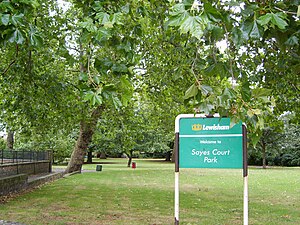
Sayes Court was a manor house and garden in Deptford, in the London Borough of Lewisham on the Thames Path and in the former parish of St Nicholas. Sayes Court once attracted throngs to visit its celebrated garden[1][2] created by the seventeenth century diarist John Evelyn. Now completely buried beneath Convoys Wharf and Sayes Court Park,[3] the area shows little sign of its former glory, despite having been a key factor in the creation of the National Trust.[4]
History
[edit]Earliest information
[edit]The Manor of Deptford was bestowed upon Gilbert de Magminot or Maminot by William the Conqueror and this is where he held the head of the barony of Maminot. In 1814 John Lyon wrote that Maminot built a castle, or castellated mansion, for himself at Deptford. Lyon noted that all traces had by then long since been buried in their ruins, but from the remains of some ancient foundations which had been discovered, the site was probably on the brow of Broomfield, near the Mast Dock and adjacent to Sayes Court.[5][6][7][8][9]
Gilbert de Magminot's great-grandson, Walkelin Maminot,[9] dying without issue in 1191, the manor fell to the share of his sister and co-heir Alice, the wife of Geoffrey de Saye. The ownership of the manor can then be traced until after the death of Charles I, when it was seized by the Parliament and a survey of the manor was taken.[6] The Manor house, Sayes Court, along with about 60 acres (240,000 m2) of land, was assigned by Parliament to the Browne family, who had occupied it for several generations by then.[6][10]
It was owned by Thomas Cardinal Wolsey, and in 1530 when he fell from Henry VIII's favour, it was given to Charles Brandon, 1st Duke of Suffolk and his wife, Mary, the French Queen.[11]
John Evelyn at Sayes Court
[edit]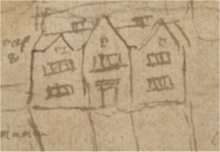
In 1647 Mary Browne, daughter and heir of Sir Richard Browne, married John Evelyn, the famous diarist, who hailed from Wotton in Surrey. With the Restoration of the monarchy, Sayes Court reverted once more to the Crown, but, having taken up residence in his wife's family home in 1651, Evelyn managed with difficulty to obtain a 99-year lease of the property from Charles II in 1663.[6][12][13]
He rebuilt and enlarged the house and, inspired by French and Italian ideas, turned the surrounding orchard and pasture into one of the most influential gardens of his day.[14][15]
The garden
[edit]Though all visible above-ground traces of the garden have been lost, its proposed design is shown in painstaking detail on a map of 1653, ostensibly drawn up for the benefit of Evelyn's father-in-law, who was on diplomatic posting to Paris and so absent while Evelyn was laying out the gardens. However, the high quality and detail of the plan probably meant that Evelyn intended it to be printed and published.[16]
Adjacent to the house on the west was a walled garden "of choice flowers, and simples", that is, medicinal herbs, laid out in formal beds surrounding a large fountain. There was also an arbour under two tall elms at the north-west corner, as well as transparent glass bee-hives. This space Evelyn regarded as his own, private garden. The rest of the gardens were on a much grander scale. The main features included: a long terrace walk overlooking an elaborate box parterre; a large rectangular area ("the grove") planted with many different species of trees, inset with walks and recesses; large kitchen gardens; a great orchard of three hundred fruit trees; avenues and hedges of ash, elm, and holly; and a long walk or promenade from a banquet house set against the south wall of the garden down to an ornamental lake with an island, fruit bushes and summer house at the north end.[15]
After the very severe winter of 1683–4, the layout of the south-west part of the garden was much simplified. The parterre was converted into a semicircle of lawn and its quadrants planted with fruit.[16]
After Evelyn
[edit]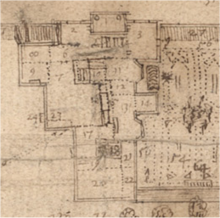
In 1694 Evelyn moved back to Wotton and in June 1696 Captain Benbow signed a three-year lease on the house. Benbow proved to be a less than ideal tenant, as Evelyn was soon writing to a friend to complain that he had "the mortification of seeing everyday much of my former labours and expenses there impairing".[17] However, much worse damage was done to the house and grounds when William III lent Sayes Court to Tsar Peter of Russia for three months in 1698. Paintings were used for target practice and the gardens were damaged by numerous wheelbarrow races.[18] Benbow demanded compensation after the Tsar's departure, to cover his own losses and reimburse Evelyn's, and the Treasury eventually paid out the sum of £350 9s 6d (equivalent to $57,780 in 2023),[19] in compensation.[20] Czar Peter also resided in a mansion house, that was situated at Hughes field, Deptford.[21][22][23]
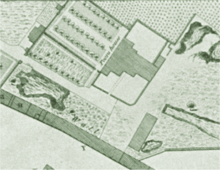
After Evelyn's death in 1706 the Sayes Court estate was held in trust for his grandson, Sir John Evelyn, Baronet, as all his own male children had predeceased him. As well as almost 62 acres around Sayes Court itself, the estate comprised 159 tenements, the Red House on the site of the later navy victualling yard, a wet and dry dock afterwards called Deadman's Dock, and a water-mill.[6][24]
18th century
[edit]After Evelyn at the turn of the 18th century the estate was quickly broken up. According to Daniel Lysons writing in 1796, the Sayes Court manor house was almost entirely demolished in 1728, and the remainder converted into a workhouse.[6] However Thomas Milton's 1753 plan of Deptford Dockyard shows the house, as the "Poore house", with still a similar footprint to that on John Evelyn's plan of 1653.[25]
Victorian era
[edit]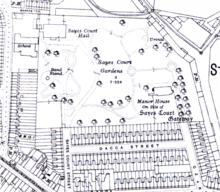

It remained the St Nicholas parish workhouse from 1759 to 1848. In 1852 it was used as a penal transportation depot, and in 1853 it was a factory for transportee clothing.[26][27] In 1856 the whole site was sold to the Admiralty.[28]
In 1869, on the closing of the dockyard, William John Evelyn, a descendant of John Evelyn, purchased back from the Government as much of the site of Sayes Court as was available. By 1876 he was turning some into a recreation ground for his Deptford tenants; all plants and turf being brought from Wotton.[28] By 1877 a 14-acre (57,000 m2) portion of the old gardens had been secured, four of these remaining attached to the old house, which in 1881 he made into almshouses.[26] The public garden and playground was about 10 acres (40,000 m2) in extent. It had been carefully laid out with grass, plants, and edged with flowers and shrubs. In part it was planted with trees, and intersected by broad and level walks. In the centre of the ground was a bandstand; and in the north-west corner there was a large neoclassical building, formerly the Dockyard's Admiralty Model house,[28] which was intended to serve as a museum and library,[29] under the management of the Goldsmiths' Company.[30]
The part played in the formation of the National Trust
[edit]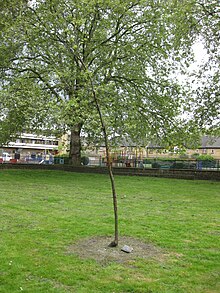
In 1884 W. J. Evelyn approached Octavia Hill with the suggestion that the garden should become publicly owned and offering the hall which could be used as a museum, but there was as yet no organisation with the necessary legal powers for holding the property for permanent preservation. Robert Hunter advised that they should set up a land company with the aim of protecting "the public interests in the open spaces of the country". Octavia Hill proposed that this company be called "the Commons and Gardens Trust", but it was Hunter's suggestion, the "National Trust", that was adopted. Unfortunately, the Trust took ten years to reach the point where it could be properly constituted, by which time the opportunity to take ownership of Sayes Court had passed.[4][31]
In 1886 some 6 acres (24,000 m2) still remained of the estate and of these W.J. Evelyn dedicated an acre and a half in perpetuity to the public. Until then the only other piece of land that had ever been given to the London public was Leicester Square. In this acre and a half the Kyrle Society laid out a park, a playground and a bandstand.[32] A permanent provision was made for the Evelyn estate to cover the expense of maintenance and caretaking. It was opened on 20 July 1886 by Baroness Burdett-Coutts.[33][34]
In his history The National Trust: The First Hundred Years, Merlin Waterson writes "It would be hard to conceive of a property which encompassed so many of the future purposes of the National Trust. The garden was of exceptional importance, the historical associations fascinating, and it was a valuable open space in the heart of London Docks."[31]
World War I and between the wars
[edit]The War Department hired Sayes Court, from the City of London Corporation from 19 September 1914 to use as a Horse Transport Reserve Depot at a rental of £90 per annum (equivalent to $10,910 in 2023)[19][35] to enlarge its Supply Reserve Depot at the adjacent former Foreign Cattle Market.[36]
The fee simple of the Foreign Cattle Market and of the Sayes Court property were purchased by the War Department, for £400,500 (equivalent to $29,362,144 in 2023)[19] under deeds dated 25 March 1926, 18 March 1927 & 25 July 1927 including the railway, tramway, wharfage and jetty rights and easements.[35]
By 1938 the almshouses had become the headquarters, while the former model house now served as the Officers Mess. Tramways (18" gauge with track weighing 35 lbs. per yard[37]) had been laid and some areas of the Victorian park remained intact within the depot.[35]
World War II
[edit]During World War II, on 16 August 1944, the Victorian Terrace existing along the Grove Street side of Sayes Court was destroyed by a V-1 flying bomb.[27][38]
Second half of the 20th century
[edit]
By the end of the war all that remained of the Sayes Court estate was a public garden of less than 2 acres (8,100 m2) and about an acre covering the sites of the bombed houses and a school.
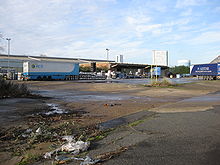
The London County Council decided to redesign the whole of this area. The resulting park included a well-equipped children's playground, a paddling pool with a fountain over artificial rocks, a heated playroom some 30 ft by 15 ft (4.6 m), with a room for an attendant at one side and on the other staff offices, lavatories and a shelter with tables and chairs facing onto a formal garden with flower beds and grass plots. At the far end of this formal garden were flower beds and a small pool fed by a spout in the form of a frog.[27][39] The park opened on 29 May 1951.[40]
In 1993 the Greenwich and Lewisham (London Borough Boundaries) Order transferred the site from the London Borough of Greenwich to the London Borough of Lewisham.[41]
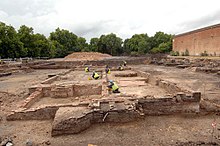
2011 investigation by Museum of London Archaeology
[edit]As part of Museum of London Archaeology's excavation at Convoys Wharf (the site of the former Deptford Royal Dockyard), Museum of London Archaeology (MOLA) unearthed the remains of Sayes Court.. The excavation identified the plan of Sayes Court, as modified in the course of its history, with ground floor walls surviving up to a metre high in places. The front door of the building in the southwest wall opened into a central hallway, with a pair of rooms either side. The hallway led to the back of the building and a further four rooms. A cellar occupied the northwest part of the building, accessed by a stair in the north corner and later by a flight of stone steps added onto the northwest wall.[42]
Present
[edit]The current Sayes Court Park (as of 2010) only incorporates the western edge of John Evelyn's Garden, and most of it overlies the area originally shown on Evelyn's map of 1653 as the 'Broome Field'. The boundary wall of Evelyn's garden follows a line extended from the eastern edge of the modern Sayes Court Street.[43]
The site of Sayes Court forms part of Convoys Wharf, which is currently owned by Hutchison Whampoa Limited and subject to a planning application to convert it into approximately 3,500 residential units, and 73,000 sq metres of commercial space[44][45] although part of this has safeguarded wharf status.[46]
In September 2011 a group of local residents launched a campaign, with the name Deptford Is.. to oppose the masterplan proposed by the developers. They have proposed a couple of projects to connect to the history of the area and benefit the local community. These are the Lenox Project and Sayes Court Garden.[47]
In October 2013 the site was added to the World Monuments Fund's 2014 watch list.[48] On 31 March 2014 the Mayor of London, Boris Johnson, approved plans to build up to 3,500 new homes on the Convoys Wharf site that has been derelict for 14 years.[citation needed]
In 2017 a locally led amenity group called DeptfordFolk nominated the 300-year-old mulberry tree for the Woodland Trust's Tree of the Year award. As a result of the campaign a small grant was awarded which led to the installation of new supports for the tree limbs. The grant was match-funded by Lewisham Council. The nomination was part of Evelyn200, a project that also saw the planting of three new trees in the park including two new white mulberry trees and a Turkish hazelnut.
Other places named after Sayes Court
[edit]- Sayes Court, Christ Church, Barbados
- Sayes Court, Addlestone, Surrey, UK
- Sayes Court, Wellington, New Zealand[49]
- Sayes Court, Isle of Sheppey[50]
References
[edit]- ^ Diary and Correspondence of John Evelyn
- ^ Who was John Evelyn? by Guy de la Bédoyère
- ^ Sayes Court Garden review at Gardenvisit.com
- ^ a b History of the National Trust: 1884–1912
- ^ England's topographer, or A new and complete history of the county of Kent by William Henry Ireland, 1830, page 731
- ^ a b c d e f Deptford, St Nicholas, The Environs of London: volume 4: Counties of Herts, Essex & Kent (1796) by Daniel Lysons, pp. 359–385
- ^ Philipott's Survey of Kent, p. 160
- ^ The history of the town and port of Dover and of Dover castle by John Lyon, published 1814, p. 139
- ^ a b Dedication to the Public of Deptford Park by Dr W.J. Collins, 1897
- ^ Records in the Land Revenue Office.
- ^ Charles Brandon: The King's Man, p.71, Sarah Bryson, 2016, MadeGlobal Publishing
- ^ Letters Patent 15 Car. II. pt. 10. 27 May. No 7.
- ^ 30 May 1663, Diary and Correspondence of John Evelyn, F.RS. Vol. I., page 374, editor William Bray, George Bell and Sons, London, 1882
- ^ london-footprints.co.uk: A Deptford & Millwall Walk
- ^ a b Plan of Sayes Court House and Garden
- ^ a b Plan of Sayes Court with lists of fruit trees
- ^ Evelyn's letter to Dr Bohun, 18 January 1697; Diary and Correspondence, 1 June 1696 and 18 January 1697
- ^ Sebag Montefiore, Simon (2016). The Romanovs. United Kingdom: Weidenfeld & Nicolson. p. 87.
- ^ a b c UK Retail Price Index inflation figures are based on data from Clark, Gregory (2017). "The Annual RPI and Average Earnings for Britain, 1209 to Present (New Series)". MeasuringWorth. Retrieved 7 May 2024.
- ^ Calendar of Treasury Books, 1697–1702, 158–9
- ^ Illustrated London News, 21 August 1858, page 186
- ^ The Moreton Bay Courier 29 December 1858, page 2
- ^ The Penny Illustrated Paper and Illustrated Times, 16 May 1874, Issue 662, page 310
- ^ Letters Patent 12 Geo. I. pt. 1. No 16.
- ^ John Evelyn's house at Sayes Court by Edward Watson, Bygone Kent, Volume 10 number 5, May 1989
- ^ a b The Kentish coast by Harper, Charles George, London Chapman & Hall, 1914. p.13
- ^ a b c An Archaeological Field Evaluation Undertaken by Pre-Construct Archaeology at Sayes Court, Deptford, SE8, London Borough of Lewisham, by Phil Frickers and Judith Connal, Pre-Construct Archaeology, 1996
- ^ a b c John Evelyn's great garden at Deptford by Edward Watson, Bygone Kent, Volume 10 number 11, November 1989
- ^ Old and New London: Volume 6, Edward Walford, 1878, pp. 143–164: Deptford
- ^ London Riverside Churches by A. E. Daniell, Archibald Constable & Co., Westminster, 1897 p.311
- ^ a b The National Trust: The First Hundred Years, by Merlin Waterson, National Trust, London, 1994, pp. 25–26
- ^ 1894 Ordnance Survey
- ^ Sayes Court, Deptford, The Times, 20 July 1886, p. 5, col F
- ^ Public Recreation Grounds, The Times, 21 July 1886, p. 9, col F
- ^ a b c Supply Reserve Depot, Deptford. (Old Foreign Cattle Market). Skeleton Record Plan. Sheet No. 1 of a set of 4. Corrected to September 1938.
- ^ Lewisham past and present, by John Coulter, Sutton Publishing, 2001
- ^ The 18" gauge is listed at "Railroad Gauge Width". Archived from the original on 13 July 2012. as also having been used at Woolwich Arsenal, Chatham Dockyard, Crewe Locomotive Works and Horwich Locomotive Works
- ^ V1's and V2's London SE8 Deptford
- ^ Sayes Court, Greenwich, Playground and Garden, London County Council Parks Department, Royal Institute of British Architects (RIBA) Journal, August 1951, pp. 396–397
- ^ New Park in South London, The Times, 30 May 1951, p. 8, col. G
- ^ The Greenwich and Lewisham (London Borough Boundaries) Order 1993
- ^ "Convoys Wharf: Sayes Court". MOLA. Retrieved 7 June 2017.
- ^ Google Earth .kmz file Archived 20 January 2012 at the Wayback Machine overlaying Evelyn's map of 1653 with the modern street map.
- ^ HardHat Communications Convoys Wharf Site Brought Back to Life, November 2009
- ^ Rogers Stirk Harbour + Partners "Convoys Wharf Conception" Archived 3 October 2009 at the Wayback Machine
- ^ "Archived copy" (PDF). Archived from the original (PDF) on 8 November 2008. Retrieved 8 November 2008.
{{cite web}}: CS1 maint: archived copy as title (link) - ^ Our campaign so far Archived 27 October 2013 at the Wayback Machine at Deptford Is ...
- ^ WMF Program: 2014 Watch
- ^ The New Zealand Free Lance, 15 February 1908
- ^ Guide Book of the Church of St. Thomas the Apostle Isle of Harty
Further reading
[edit]- England's topographer, or A new and complete history of the county of Kent by William Henry Ireland, published 1830 pages 731 to 738.
- The Home-life of English Ladies in the XVII. Century, published 1860 up to page 134
- Convoys Wharf, Deptford; TQ 3700 7820; (David Divers); evaluation; 9 October – 14 November 2000; CgMs Consulting on behalf of News International PLC; CVW00
- Sayes Court, Deptford, London Borough of Lewisham, TQ 3680 7798; (Phil Frickers); evaluation; Hyde Housing Association; GRV96
- A History of Deptford by Dews, N, London, 1884
- Diagram & Examples of the French Style of Garden Design in the British Isles after the Restoration
- John Evelyn, ed. Maggie Campbell-Culver (2009), Directions for the Gardiner and Other Horticultural Advice, Oxford University Press, ISBN 978-0-19-923207-9
- John Evelyn's house at Sayes Court by Edward Watson, Bygone Kent, Volume 10 number 5, May 1989
- John Evelyn's great garden at Deptford by Edward Watson, Bygone Kent, Volume 10 number 11, November 1989
Attribution
[edit]![]() This article incorporates text from this source, which is in the public domain: Lyon, John (1814). The History of the Town and Port of Dover and of Dover Castle. pp. 139
This article incorporates text from this source, which is in the public domain: Lyon, John (1814). The History of the Town and Port of Dover and of Dover Castle. pp. 139
External links
[edit]- Voice4Deptford, local group to enable community participation in redevelopment of the Convoys Wharf site.
- Sayes Court – A project to create a new garden and centre for landscape at Sayes Court.
- London's Lost Garden about Sayes Court Garden and John Evelyn.
- Plan of Sayes Court House and Garden at the British Library and as an overlay (.kmz file) on the modern landscape on Google Earth
- Plan of Sayes Court with lists of fruit trees at the British Library and as an overlay (.kmz file) on the modern landscape on Google Earth
- Thread for Sayes Court manor house and gardens overlays on Google Earth Community forums
- Lewisham Council's Convoys Wharf outline planning application
- Convoys Opportunity Groups' Objections to planning application for Convoys Wharf
- Rogers Stirk Harbour + Partners "Convoy's Wharf Conception"
- Lewisham Unitary Development Plan 2004, Schedule 3 – Areas of Archaeological Priority protected by Policy URB 21 Archaeology and shown on the Proposals Map

